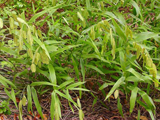Native Plants

Q. Who is Mr. Smarty Plants?
A: There are those who suspect Wildflower Center volunteers are the culpable and capable culprits. Yet, others think staff members play some, albeit small, role. You can torture us with your plant questions, but we will never reveal the Green Guru's secret identity.
Did you know you can access the Native Plant Information Network with your web-enabled smartphone?
Ask Mr. Smarty Plants is a free service provided by the staff and volunteers at the Lady Bird Johnson Wildflower Center.

rate this answer
Saturday - August 06, 2011
From: Houston, TX
Region: Southeast
Topic: Compost and Mulch, Turf, Grasses or Grass-like
Title: Native grasses for central Georgia
Answered by: Guy Thompson
QUESTION:
We've just bought a 1990 circa house in Dallas, Georgia. It sits on a .62 acre lot. One half of the lot is woods, the rest is lawn. The lawn is covered mostly with weeds and wild strawberries. We don't live there full time so landscaping needs to be weed and maintenance free. We would prefer to not mow, but we'll do what we have to do. The soil is Georgia clay, rocks, and hilly. Bermuda grows great there, but I don't like it's encroachment into flower beds. I would prefer to use a native grass that grows slowly and cuts down on mowing. Is there a native grass that we would plug into lawn as it is now and then the plugs would eventually choke out the weeds? Thank youANSWER:
Mr. Smarty Plants believes that your best bet would be to choose from native bunch grasses that grow well in your area. They may not be quite as fast and effective as turf grasses, e.g., Bermuda or carpet grass, in choking out weeds, but they would not be invasive into flower beds. A number of potential choices are listed in this web site for Piedmont grasses, I would suggest Schizachyrium scoparium (Little bluestem), Aristida purpurea (Purple threeawn), Muhlenbergia capillaris (Gulf muhly) or a mixture of these for the sunny areas of your lot. A lower-growing, somewhat weedy choice would be Paspalum setaceum (Thin paspalum), which will grow in full sun but prefers partial sun. For the shady areas near the woods, Chasmanthium latifolium (Inland sea oats) would thrive. Seeds of these species should be available from local suppliers, such as Rock Spring Farm, or Native American Seed. The preferred time for planting the seeds is spring. Till the soil no deeper than two inches; rake level, and roll the soil lightly to make the bed firm. Remove all existing weeds. Because tilling often stimulates weed germination, it is advisable to water the bed one to two weeks before planting. This encourages weed germination. Weed seedlings can be killed by hand-pulling, laying a sheet of plastic over the weeds until the sun cooks them out, or by using a post-emergent, non-residual herbicide. You may need to repeat this procedure several times to ensure a clean bed. Starting with a clean bed is much easier than eliminating weeds after planting. Planting can be done by hand-broadcasting or with a garden planter. If you hand-broadcast seeds, be sure to distribute them evenly, then cover the seeds with one-half inch or less of soil or a light layer of compost. This can be accomplished by raking in two different directions in loose topsoil. Water new plantings regularly to assure germination and root establishment. Optimum growing temperatures are 80 to 95 degrees Fahrenheit during the day, and around 68 degrees Fahrenheit at night.
From the Image Gallery
More Turf Questions
Did my neighbor's zucchini affect my apple tree from Oak Lawn, IL
October 26, 2009 - My neighbor planted zucchini plants near a flowering non-fruit producing apple tree in my yard. Soon afterwards in July the tree began to shed leaves. Could the zucchini plant have caused this?
view the full question and answer
Low maintenance, water and height lawn
September 10, 2007 - We would like to replace our lawn that covers a large area of our front and back yard and is watered daily and twice a day in summertime with drought resistant plants. Mr. Smarty Plants, could you rec...
view the full question and answer
Native grasses for shady yard in Austin
September 04, 2011 - I was looking at your research on native grasses to be used in a yard. I want to plant your native mix of seeds, but worry that there is too much shade in my yard. I live in central Austin and wante...
view the full question and answer
Looking for a native turf grass for the Houston area
July 25, 2013 - Looking for a native turf grass for the Houston area. In some of your 2012 responses, you stated that "The good news is that research into turf-type grasses native to the coastal region is in the pla...
view the full question and answer
Elimination of non-native, invasive King Ranch bluestem in lawn
June 06, 2006 - How can I eliminate an annual infestation of king ranch bluestem in my bermuda lawn?
Thanks.
view the full question and answer
| Support the Wildflower Center by Donating Online or Becoming a Member today. |

